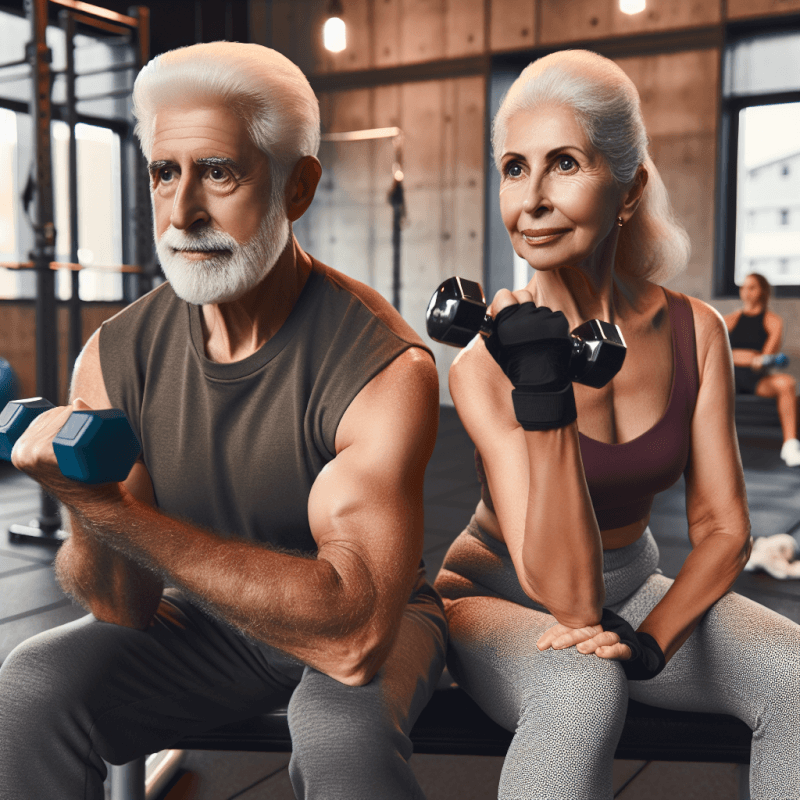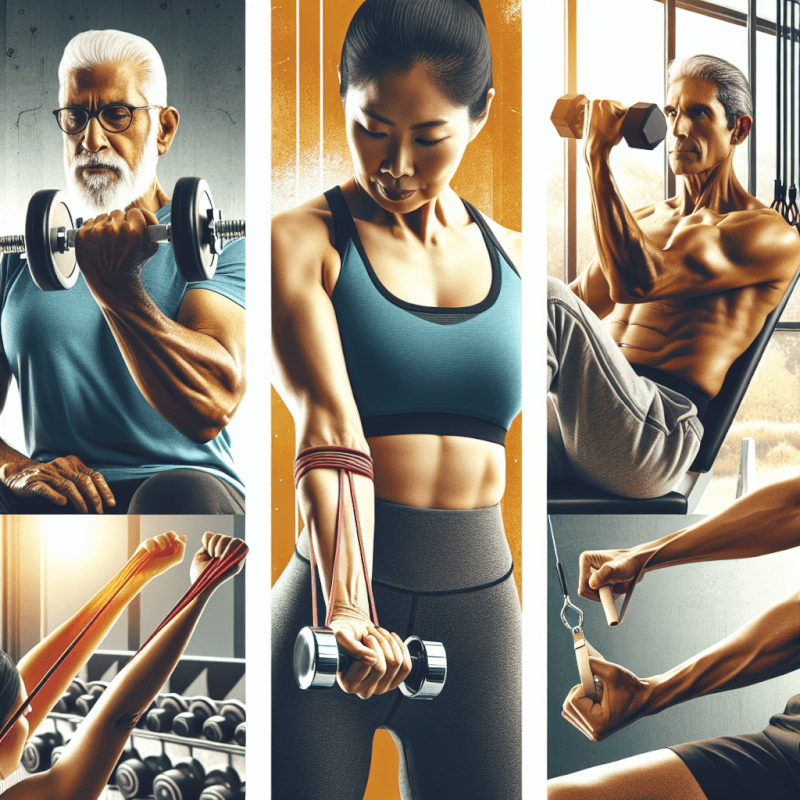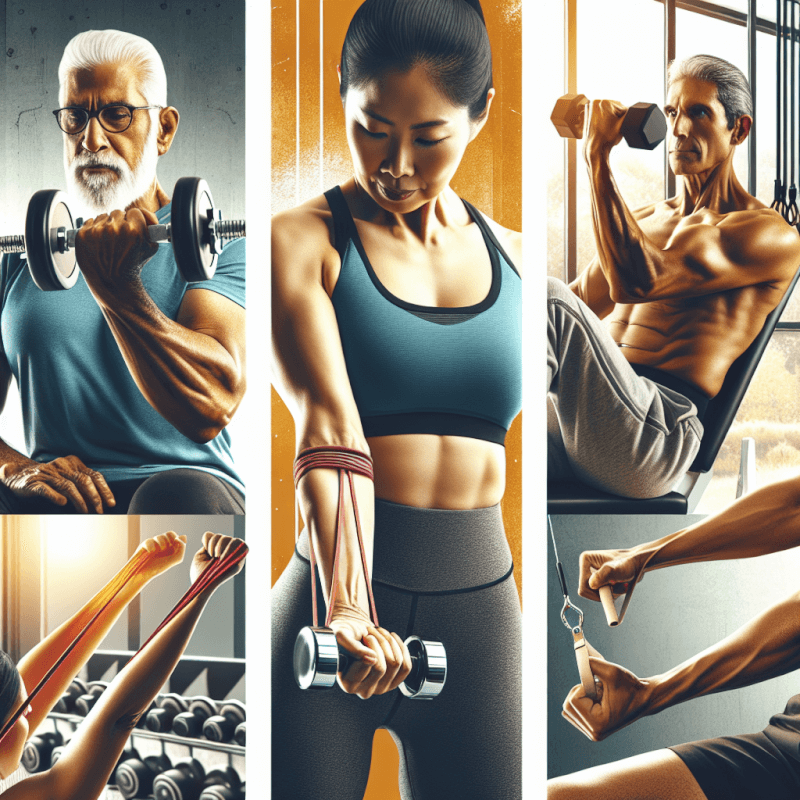Are you over 50 and looking to strengthen and tone your arms? Look no further! In this article, you will discover a variety of effective arm workouts specifically designed for individuals over 50. These exercises will help you build muscle, increase flexibility, and improve overall arm strength. Whether you’re a beginner or have been working out for years, these arm workouts for over 50 will challenge and energize you. Get ready to sculpt those beautiful arms and feel confident and strong in your own skin. Let’s get started!
1. Importance of Arm Workouts
Taking care of your arms becomes increasingly important as you get older. Arm workouts not only help you maintain muscle mass and strength but also improve overall arm function and enhance bone health. As we age, our muscles naturally begin to weaken and atrophy, making it more challenging to perform daily tasks and maintain independence. However, with regular arm workouts, you can counteract these effects and enjoy a stronger, healthier, and more functional upper body.
1.1 Benefits of Arm Workouts for Over 50
Engaging in arm workouts specifically designed for individuals over 50 provides a multitude of benefits. Firstly, these exercises help prevent muscle loss, which tends to accelerate with age. By preserving and even increasing muscle mass through targeted exercises, you can maintain a higher metabolic rate, making weight management easier. In addition, stronger arm muscles assist in maintaining proper posture, reducing the chances of developing back and neck pain.
1.2 Maintaining Muscle Mass and Strength
Perhaps the most significant benefit of arm workouts for individuals over 50 is the ability to maintain muscle mass and strength. Engaging in resistance training exercises, such as bicep curls and triceps dips, helps stimulate muscle fibers, preventing them from wasting away. With consistent effort, you can promote muscle growth and retain your strength, making everyday activities like lifting groceries or carrying bags much easier.
1.3 Improving Overall Arm Function
Arm workouts also play a crucial role in improving overall arm function. By targeting different muscle groups and engaging in exercises that promote mobility and flexibility, you can enhance your ability to perform various tasks. This includes activities such as reaching overhead, lifting objects, and performing functional movements with ease. Stronger and more functional arms enable you to maintain an active and independent lifestyle as you age.
1.4 Enhancing Bone Health
As you age, maintaining bone density and strength becomes increasingly important to prevent conditions like osteoporosis and reduce the risk of fractures. Arm workouts that involve resistance training help stimulate bone remodeling and increase bone density. Exercises such as overhead presses and push-ups can offer significant benefits to your arm bones, helping to enhance their strength and resilience.
2. Warm-Up Exercises
Before diving into your arm workout routine, it’s crucial to warm up your muscles and prepare them for the physical activity ahead. Warm-up exercises increase blood flow to the muscles, improving flexibility and reducing the risk of injury. Here are some effective warm-up exercises you can incorporate into your arm workout routine:
2.1 Shoulder Rolls
Start by standing tall with your feet shoulder-width apart. Relax your arms by your sides. Slowly roll your shoulders forward in a circular motion for 10-15 seconds. Then, reverse the direction and roll your shoulders backward for another 10-15 seconds. Shoulder rolls help loosen up the muscles and joints in your shoulders, preparing them for the upcoming arm exercises.
2.2 Arm Circles
Extend your arms straight out to the sides at shoulder height. Begin making small circular motions with your arms, gradually increasing the size of the circles. Complete 10-15 circles in one direction, then switch and do 10-15 circles in the opposite direction. Arm circles help warm up the muscles in your shoulders and upper arms, improving their flexibility and range of motion.
2.3 Wrist Flexor and Extensor Stretches
Extend one arm in front of you, palm facing up. Use your opposite hand to gently pull back on your fingers, feeling a stretch in your forearm. Hold this position for 15-30 seconds. Next, flip your hand so the palm faces down and repeat the same stretch, this time feeling the stretch in the opposite side of your forearm. Perform the same stretches on the other arm. Wrist flexor and extensor stretches help loosen up the muscles and tendons in your forearms, allowing for better wrist mobility during arm exercises.
2.4 Triceps Stretch
Stand upright and extend one arm overhead. Bend your elbow and reach your hand behind your head, placing it between your shoulder blades. With your opposite hand, gently press down on your elbow, feeling a stretch in the back of your upper arm. Hold this stretch for 15-30 seconds, then repeat on the other side. Triceps stretches help warm up and elongate the triceps muscles, ensuring they are ready for the workout ahead.

3. Resistance Training
Resistance training exercises are an effective way to build and strengthen your arm muscles. They involve using external resistance, such as dumbbells or resistance bands, to challenge your muscles and promote growth. Here are some resistance training exercises specifically targeting your arms:
3.1 Bicep Curls
Hold a dumbbell in each hand, arms fully extended by your sides and palms facing forward. Keep your elbows close to your torso and slowly lift the dumbbells towards your shoulders. Pause at the top, then slowly lower the weights back down to the starting position. Aim for 2-3 sets of 12-15 repetitions. Bicep curls primarily target the muscles in your biceps, helping to strengthen and tone them.
3.2 Triceps Dips
Find a sturdy surface, such as a bench or chair. Sit on the edge and place your hands shoulder-width apart, gripping the edge of the surface with your fingers facing forward. Walk your feet forward, keeping your knees bent at a 90-degree angle. Lower yourself down by bending your elbows, aiming to bring your hips as low as possible without touching the ground. Push yourself back up to the starting position, engaging your triceps. Perform 2-3 sets of 10-12 repetitions. Triceps dips are an effective exercise for targeting the muscles in the back of your upper arms.
3.3 Hammer Curls
Stand tall with a dumbbell in each hand, arms fully extended by your sides and palms facing your body. Keep your elbows close to your torso and slowly lift the dumbbells towards your shoulders, maintaining the same hand position throughout the movement (palms facing your body). Pause at the top, then slowly lower the weights back down to the starting position. Aim for 2-3 sets of 12-15 repetitions. Hammer curls target both your biceps and forearms, providing a comprehensive workout for your arms.
3.4 Overhead Press
Stand tall with a dumbbell in each hand, palms facing forward. Lift the dumbbells to shoulder height, keeping your elbows bent and level with your shoulders. Press the weights overhead, extending your arms fully. Slowly lower the dumbbells back down to shoulder height, then repeat the movement for 2-3 sets of 10-12 repetitions. Overhead presses primarily target the muscles in your shoulders, but also engage the triceps and upper back muscles.
3.5 Push-Ups
Assume a high plank position with your hands slightly wider than shoulder-width apart, fingers pointing forward. Keep your body in a straight line from head to toe. Lower your body by bending your elbows, keeping them close to your sides, until your chest nearly touches the ground. Push yourself back up to the starting position, engaging your chest, triceps, and shoulders. Aim for 2-3 sets of as many repetitions as possible with good form. Push-ups are a compound exercise that works multiple muscles in your arms, chest, and core.
4. Bodyweight Exercises
When equipment is not readily available, bodyweight exercises offer an effective way to work your arm muscles. These exercises require no external resistance and rely solely on your body weight to provide the necessary challenge. Here are some bodyweight exercises you can incorporate into your arm workout routine:
4.1 Arm Circles
Stand with your feet shoulder-width apart and extend your arms straight out to the sides at shoulder height. Begin making small circular motions with your arms, gradually increasing the size of the circles. Complete 10-15 circles in one direction, then switch and do 10-15 circles in the opposite direction. Arm circles are a simple yet effective exercise for targeting the muscles in your shoulders and upper arms.
4.2 Plank with Arm Raises
Assume a high plank position with your hands directly under your shoulders and your body in a straight line from head to toe. Engage your core and glutes to maintain stability. Slowly lift one arm off the ground, extending it straight out in front of you. Hold for a few seconds, then lower the arm back down and repeat with the other arm. Aim for 2-3 sets of 10-12 arm raises per side. This exercise not only targets your arms but also engages your core to improve stability.
4.3 Diamond Push-Ups
Assume a high plank position with your hands close together, directly under your chest, forming a diamond shape with your thumbs and index fingers. Keep your body in a straight line from head to toe. Lower your body by bending your elbows, keeping them close to your sides, until your chest nearly touches the diamond shape formed by your hands. Push yourself back up to the starting position, engaging your triceps and chest. Perform 2-3 sets of as many repetitions as possible with good form. Diamond push-ups place greater emphasis on the triceps compared to regular push-ups.
4.4 Shadow Boxing
Stand with your feet shoulder-width apart, knees slightly bent. Make a fist with each hand and bring them up to your chin, guarding your face. Begin throwing punches by extending your arms, alternating between left and right punches. Imagine you are punching an imaginary target in front of you. Move gracefully with control, focusing on proper form and technique. Incorporate shadow boxing into your arm workout routine to engage various muscles in your arms, shoulders, and core.
4.5 Wall Push-Ups
Stand facing a wall, approximately arms’ length away. Place your palms against the wall at shoulder height, slightly wider than shoulder-width apart. Step back and lean forward, supporting your weight on your hands. Bend your elbows and lower your upper body toward the wall, keeping your body in a straight line from head to toe. Push yourself back to the starting position, engaging your arms and chest. Aim for 2-3 sets of 10-12 repetitions. Wall push-ups are a modified version of traditional push-ups that allow you to gradually build strength.

5. Flexibility and Stretching
Flexibility and stretching exercises play a crucial role in arm workouts, promoting joint mobility, reducing muscle imbalances, and improving overall range of motion. Incorporating these exercises into your routine helps prevent injuries and improves muscle recovery. Here are some essential flexibility and stretching exercises for your arms:
5.1 Wrist Flexor Stretch
Extend one arm in front of you, palm facing up. Use your opposite hand to gently pull back on your fingers, feeling a stretch in your forearm and wrist. Hold this position for 15-30 seconds. Repeat the stretch on the other arm. Wrist flexor stretches help increase the flexibility and alleviate tension in the muscles and tendons of your forearms.
5.2 Wrist Extensor Stretch
Extend one arm in front of you, palm facing down. Use your opposite hand to gently press down on the back of your hand, feeling a stretch in your forearm and wrist. Hold this position for 15-30 seconds. Repeat the stretch on the other arm. Wrist extensor stretches complement the wrist flexor stretches by targeting the muscles on the opposite side of your forearms.
5.3 Shoulder Stretch
Stand tall with your feet shoulder-width apart. Reach one arm across your body, placing it just above your elbow with your opposite hand. Gently pull the extended arm toward your chest until you feel a stretch in your shoulder. Hold this stretch for 15-30 seconds, then repeat on the other arm. Shoulder stretches help improve the flexibility and range of motion in your shoulder joints.
5.4 Triceps Stretch
Reach one arm overhead, bending it at the elbow so that your hand is reaching toward the opposite shoulder blade. Use your opposite hand to gently press down on your elbow, feeling a stretch in the back of your upper arm. Hold this stretch for 15-30 seconds, then repeat on the other arm. Triceps stretches target the muscles at the back of your upper arms and promote flexibility.
5.5 Arm and Chest Stretch
Stand tall with your feet shoulder-width apart. Extend both arms straight behind you, interlocking your fingers with your palms facing downward. Gently lift your arms as far as comfortable, feeling a stretch in your chest and the fronts of your shoulders. Hold this stretch for 15-30 seconds. This stretch helps open up your chest and shoulders, improving overall arm mobility.
6. Incorporating Cardiovascular Exercises
While resistance training and bodyweight exercises are essential for building arm strength, incorporating cardiovascular exercises into your workout routine offers numerous benefits to your overall health and fitness. Cardiovascular exercises elevate your heart rate and improve cardiovascular endurance, enhancing your body’s ability to deliver oxygen and nutrients to your muscles. Here are some cardiovascular exercises that can be incorporated into your arm workouts:
6.1 Benefits of Cardiovascular Exercises
Engaging in cardiovascular exercises provides a wide range of benefits beyond the improvement of arm strength. It helps reduce the risk of chronic diseases, including heart disease and diabetes. Cardiovascular exercises also promote weight loss, enhance mental health, boost energy levels, and improve sleep quality. By including cardiovascular exercises in your arm workouts, you can experience overall health improvements and complement your strength training efforts.
6.2 Walking
Walking is a low-impact cardiovascular exercise that can be easily incorporated into your daily routine. Aim for at least 150 minutes of moderate-intensity walking per week. To engage your arms during your walk, swing them naturally back and forth. This arm movement helps increase calorie burn and adds an additional level of intensity to your walking workout.
6.3 Cycling
Cycling is another excellent cardiovascular exercise that provides a low-impact option for arm workouts. Whether you prefer outdoor cycling or using a stationary bike, pedaling engages the muscles in your arms, shoulders, and back. Aim for 150 minutes of moderate-intensity cycling each week, or mix it up by incorporating high-intensity interval training (HIIT) sessions for an extra challenge.
6.4 Swimming
Swimming is a whole-body cardiovascular exercise that not only engages your arms but also works your legs and core. The resistance of the water provides a challenging workout while being gentle on your joints. Aim for at least 150 minutes of moderate-intensity swimming per week. Mix up your strokes to target different muscles, emphasizing freestyle and butterfly strokes for a more arm-intensive workout.
6.5 Aerobic Classes
Participating in aerobic classes, such as dance-based workouts or step aerobics, can help elevate your heart rate and provide a fun and engaging way to work your arms. These classes often incorporate arm movements and choreographed routines to improve cardiovascular fitness while targeting specific muscle groups. Consider attending classes that involve arm-focused movements to reap the benefits of cardiovascular exercise and arm strengthening simultaneously.

7. Safety Tips and Precautions
When engaging in arm workouts, it’s essential to prioritize safety and take precautions to prevent injuries. Here are some safety tips to keep in mind:
7.1 Consult with a Healthcare Professional
Before starting any new exercise routine, especially if you have pre-existing medical conditions or concerns, it’s crucial to consult with a healthcare professional. They can provide guidance and ensure that the exercises you choose are appropriate for your current health status.
7.2 Start Slowly and Gradually Increase Intensity
When beginning arm workouts, start with lighter weights or resistance and gradually increase the intensity as you build strength and confidence. Avoid pushing yourself too hard too soon, as this can lead to muscle strain or injury. Listen to your body and progress at a pace that feels comfortable and manageable for you.
7.3 Use Proper Form and Technique
Using proper form and technique is vital to maximize the effectiveness of your arm workouts and minimize the risk of injury. When performing exercises, pay attention to your posture, alignment, and the specific movement patterns. If you are unsure about the correct form, consider seeking guidance from a qualified fitness professional or watching instructional videos.
7.4 Listen to Your Body
While it’s essential to challenge yourself during workouts, it’s equally important to listen to your body’s cues. If you experience pain, discomfort, or any other unusual sensations during an exercise, stop immediately and assess the situation. Pushing through pain can lead to further injury, so always prioritize your well-being and adjust the intensity or modify the exercise as needed.
7.5 Avoid Overexertion and Injury
To prevent overexertion and injury, it’s important to incorporate rest days into your workout routine. Allow your muscles time to recover and repair between arm workouts. Furthermore, avoid overloading your muscles with excessive weight or resistance, as this can lead to strain or muscle damage. Balance your workouts with adequate rest and recovery for optimum results.
8. Frequency and Progression
To achieve optimal results from your arm workouts, it’s important to consider frequency and progression. Here are some guidelines to help you determine the appropriate frequency and progression for your workouts:
8.1 Determining the Appropriate Frequency
The frequency of your arm workouts will depend on factors such as your current fitness level, goals, and recovery ability. As a general guideline, aim for 2-3 arm workouts per week, allowing at least 48 hours of rest between sessions. This allows your muscles to recover and adapt to the stress placed upon them, promoting muscle growth and strength gains.
8.2 Gradually Increase Weight or Resistance
To continually challenge your muscles and promote growth, it’s important to gradually increase the weight or resistance used during your arm workouts. This progressive overload principle ensures that your muscles are consistently stimulated and prevents plateauing. Start with a weight or resistance level that allows you to complete the desired number of repetitions with proper form, and then gradually increase the load as you become stronger.
8.3 Varying Exercises
Adding variety to your arm workouts is essential for preventing boredom, targeting different muscle groups, and avoiding overuse injuries. Incorporate different exercises that target various aspects of your arm muscles, such as bicep curls, triceps dips, and hammer curls. Experiment with different types of equipment, such as dumbbells, resistance bands, or even your own body weight, to keep your workouts interesting and challenging.
8.4 Allowing Rest and Recovery
Rest and recovery are integral parts of any exercise routine, as they allow your muscles to repair and grow stronger. Avoid overtraining your arms by incorporating rest days into your workout schedule. This means having at least one or two days of complete rest from arm-specific exercises each week. Additionally, ensure you are getting adequate sleep and proper nutrition to support the recovery process.

9. Customizing Arm Workouts
Every individual has different fitness levels, goals, and preferences when it comes to arm workouts. It’s important to customize your exercises and routines to suit your specific needs. Here are some factors to consider when customizing your arm workouts:
9.1 Individual Fitness Levels and Goals
Consider your current fitness level and goals when designing your arm workouts. If you are a beginner, start with lighter weights or lower resistance and focus on mastering proper form and technique. For intermediate or advanced individuals, challenge yourself with heavier weights or increased resistance to continue progressing. Tailor your arm exercises to target the specific areas you wish to focus on, whether it’s building muscle, increasing strength, or improving aesthetics.
9.2 Modifying Exercises
Not all arm exercises may be suitable or accessible to everyone. Modify exercises as needed to accommodate your individual circumstances. For example, if you have wrist or shoulder issues, you can substitute certain exercises with alternatives that place less strain on those joints. Don’t be afraid to make modifications that preserve your safety and comfort.
9.3 Adding Variety
To keep your arm workouts engaging and enjoyable, add variety by introducing new exercises and techniques. Explore different types of equipment, try new bodyweight exercises, or incorporate alternative training methods such as resistance bands or yoga. This variety not only keeps your workouts interesting but also challenges your muscles in different ways, promoting continuous progress.
9.4 Tracking Progress
Tracking your progress is an excellent way to stay motivated and assess the effectiveness of your arm workouts. Keep a workout journal or use fitness tracking apps to record the weights, reps, and sets for each exercise. Regularly review your progress and make adjustments to your routines as needed. It’s a satisfying feeling to see improvements over time, whether it’s in the form of increased weights, enhanced endurance, or improved muscle definition.
10. Benefits of Strong Arms in Daily Life
Having strong arms offers numerous advantages in daily life, especially as we age. Here are some benefits that strong arms provide:
10.1 Easier Activities of Daily Living
Strong arms make everyday tasks much easier to perform. From lifting groceries and carrying heavy bags to opening jars or pushing doors, having the strength and functionality in your arms improves your independence and quality of life. Your arms become reliable tools, allowing you to tackle daily activities with ease and confidence.
10.2 Improved Body Symmetry
Strong arms contribute to improved body symmetry and aesthetics. Well-developed arm muscles enhance the overall appearance of your upper body, creating a balanced and toned physique. This can boost your self-confidence and body image, leading to improved mental and emotional well-being.
10.3 Enhanced Self-Confidence
When you feel physically strong and capable, it naturally boosts your self-confidence. Having strong arms allows you to feel more self-assured in your physical abilities, whether it’s playing sports, engaging in recreational activities, or simply navigating through daily life. This increased self-confidence extends beyond the physical realm and positively impacts various aspects of your life.
10.4 Better Overall Health and Well-Being
Engaging in regular arm workouts leads to better overall health and well-being. By preserving muscle mass, improving bone density, and enhancing cardiovascular fitness, you’re promoting a healthy body composition and reducing the risk of chronic diseases. Additionally, regular exercise releases endorphins, which promote feelings of happiness and reduce stress, leading to improved mental and emotional well-being.
In conclusion, arm workouts for individuals over 50 offer significant benefits in maintaining muscle mass and strength, improving overall arm function, and enhancing bone health. By incorporating warm-up exercises, resistance training, bodyweight exercises, flexibility and stretching routines, cardiovascular exercises, and following safety precautions, you can customize your arm workouts to meet your specific needs and achieve optimal results. Strong arms not only contribute to daily life tasks becoming easier but also improve body symmetry, boost self-confidence, and enhance overall health and well-being. So grab some dumbbells, put on your workout gear, and start working towards stronger, healthier arms today!



